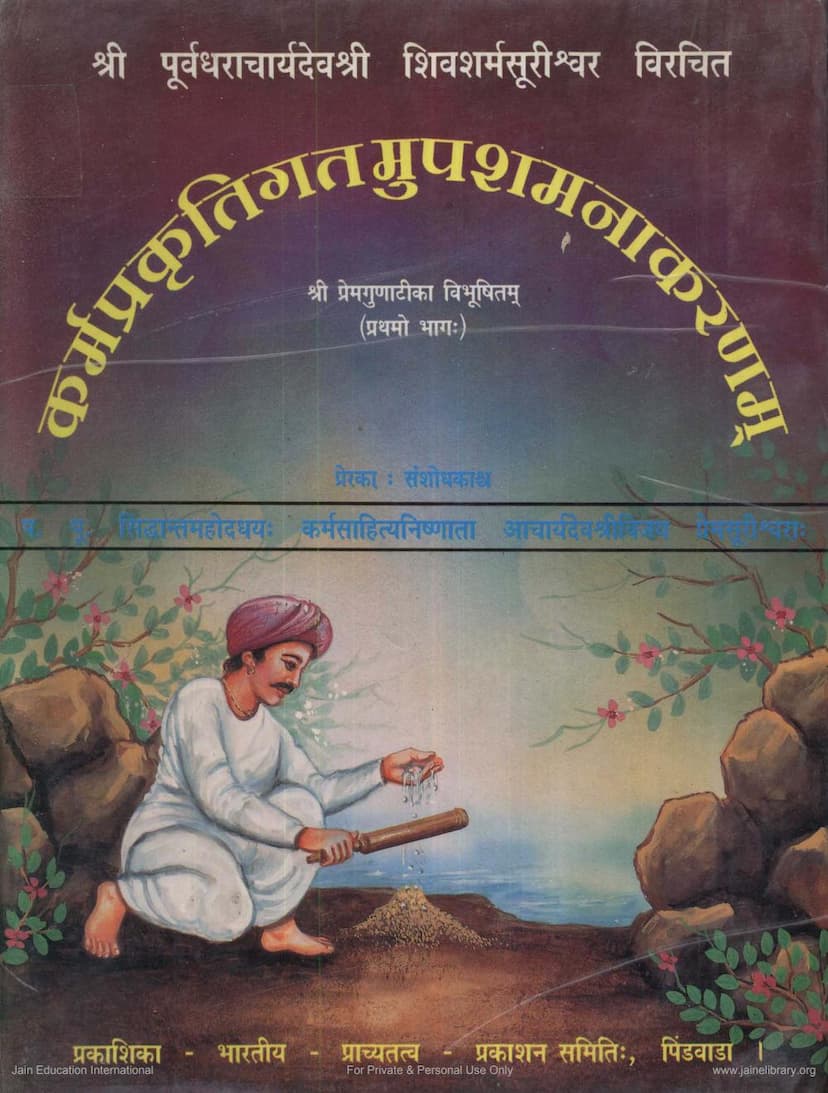Karmaprakrutigatmaupashamanakaranam
Added to library: September 2, 2025

Summary
Certainly! Here's a comprehensive summary of the Jain text "Karmaprakrutigatmaupashamanakaranam" (कर्मप्रकृतिगतमुपशमनाकरणम्), based on the provided pages and catalog link.
Book Title: Karmaprakrutigatmaupashamanakaranam (कर्मप्रकृतिगतमुपशमनाकरणम्) - This translates to "Karmaprakrutigatmaupashamanakaranam" or "The Practice of Pacification (Upashamana) of Karma Nature."
Authors:
- Original Work: Shivsharmsuri (शिवशर्मसूरीश्वर)
- Commentary (Tika): Gunratnasuri (गुणरत्नसू रीश्वर), specifically "Premguna Tika" (प्रेमगुणाटीका).
- Inspiration/Guidance/Research: Acharya Shri Vijaypremsurishwarji (आचार्यदेव श्री म dvd Vijaypremsurishwarji).
Publisher: Bharatiya Prachyatattva Prakashan Samiti (भारतीय प्राच्यतत्व प्रकाशन समिति), Pindwada (पिंडवाडा).
Catalog Link: https://jainqq.org/explore/001832/1
Core Subject: The book is a detailed exposition of the Jain concept of Upashamana (उपशमन), which refers to the pacification or suppression of karmic influx and its effects on the soul. Specifically, it focuses on the Upashamanakaranam (उपशमनाकरणम्) aspect within the framework of karma theory, likely detailing the stages and processes by which karmas are pacified.
Key Concepts Explained:
-
Upashamana (उपशमन): The primary subject. It's a method of pacifying or suppressing the manifestation of karmas, particularly the Mohaniya Karma (मोहनीय कर्म), which is responsible for deluded states.
- Two Types of Upashamana:
- Karanakrutopashamana (करणकृतोपशमना): Upashamana achieved through specific practices and spiritual efforts (Karanas). This is the main focus of the text.
- Akarankrutopashamana (अकरणकृतोपशमना): Upashamana that arises spontaneously or through grace without direct effort. (The text notes that the continuous practice of Akarankrutopashamana has ceased in the current era, and the focus is on Karanakrutopashamana).
- Two Types of Karanakrutopashamana:
- Sarvopashamana (सर्वोपशमना): Complete pacification of Mohaniya karma.
- Deshopashamana (देशोपशमना): Partial pacification of Mohaniya karma.
- Two Types of Upashamana:
-
Karma Theory: The book delves into the intricacies of Jain karma theory, explaining the stages of karma:
- Bandha (बन्ध): Binding of karma particles to the soul.
- Satta (सत्ता): The state of karmas being present with the soul.
- Udaya (उदय): The active manifestation and fruition of karmas.
- Udirana (उदीरणा): Premature activation of karmas.
- Udvartana (उद्वर्तना): Increasing the intensity or duration of karma.
- Apavartana (अपवर्तना): Decreasing the intensity or duration of karma.
- Sankramana (संक्रमण): Transformation of one type of karma into another.
- Upashamana (उपशमना): Pacification or suppression of karma.
- Nidhati (निधत्ति): Karma that cannot be altered in its intensity or duration.
- Nikachana (निकाचना): Karma that is completely bound and unalterable.
- Abadha (अबाधा): The period during which bound karma does not yield results.
-
Karanas (करण): The spiritual efforts or stages undertaken for Upashamana. The text details:
- Yathapravrittikarana (यथाप्रवृत्तकरण): The initial stage of effort, characterized by gradual but not infinitely escalating effort.
- Apuvvakarana (अपूर्वकरण): The stage of unprecedented effort, where new states and intensities of effort are reached.
- Anivrittikarana (अनिवृत्तिकरण): The stage of unceasing effort, where progress becomes fixed and unalterable until the stage is completed.
-
Samyaktva (सम्यक्त्व): The path of Right Faith, Knowledge, and Conduct is central to achieving Upashamana. The text discusses the attainment of:
- Aupashamik Samyaktva (औपशमिक सम्यक्त्व): Right faith achieved through pacification of Mohaniya karma. This is a crucial step in the process.
- Kshayopashamik Samyaktva (क्षायोपशमिक सम्यक्त्व): Right faith achieved through the destruction and pacification of karmas.
- Kshayik Samyaktva (क्षायिक सम्यक्त्व): Right faith achieved through the complete destruction of certain karmas.
-
Stages of Soul's Progress (Gunasthana - गुणस्थान): The text describes how the process of Upashamana is linked to the soul's progression through the various Gunasthanas, particularly the stages from the 4th (Avirata Samyagdrushti) upwards, leading to the 7th (Apra-matta Samyata) and the process of pacifying Mohaniya karma. The commentary on the illustration highlights stages 1 to 11, showing the journey from Mithyatva (delusion) to Upashanta Moha (pacified delusion).
-
Detailed Process: The book likely provides very granular details on the mathematical and philosophical aspects of karma, including the calculation of time periods, intensity of karmic influx, and the specific karmic particles affected at each stage of Upashamana. This is evident from the detailed explanations of "sthiti-ghata" (स्थितिघात), "rasa-ghata" (रसघात), "gunashreni" (गुणश्रेणि), and "dalanikshepa" (दलिकनिक्षेप) – concepts related to the modification and application of karmic matter.
Structure and Commentary:
- The original work by Shivsharmsuri is a foundational text on Upashamana within karma prakriti.
- The "Premguna Tika" by Gunratnasuri is a significant commentary that makes the complex original text accessible and understandable. It elaborates on the concepts, providing interpretations and further details.
- The overall work is presented as a jewel in the Jain literary tradition, particularly in the vast field of "Karma Sahitya" (कर्मसाहित्य).
Significance: The text is a profound exploration of a key Jain spiritual practice aimed at overcoming karmic bondage and achieving liberation. It emphasizes the detailed understanding of karma's nature and the systematic effort required for its pacification and eventual eradication. The commentary by Gunratnasuri, supported by Acharya Vijaypremsurishwarji, makes this complex subject comprehensible for students of Jain philosophy.
In essence, "Karmaprakrutigatmaupashamanakaranam" is a scholarly and practical guide to understanding and performing the spiritual discipline of Upashamana in Jainism, offering a deep dive into the mechanics and spiritual journey associated with it.